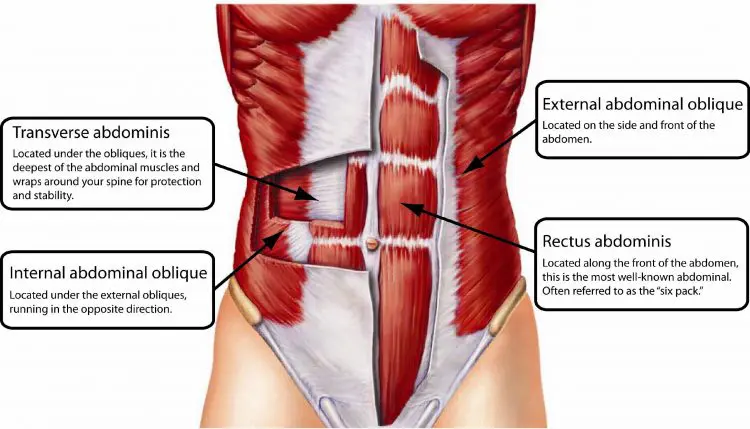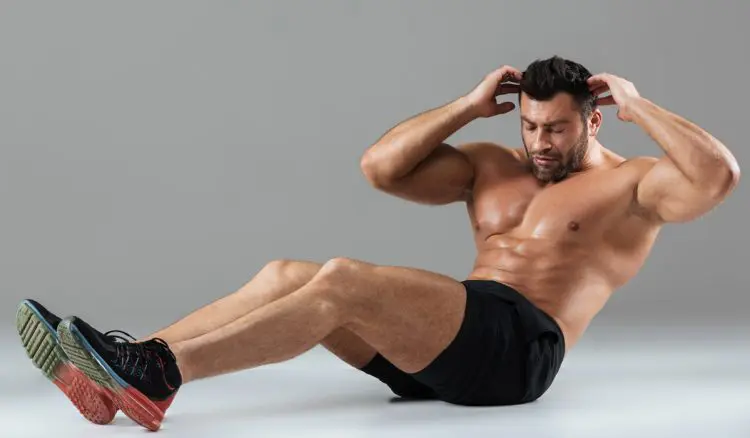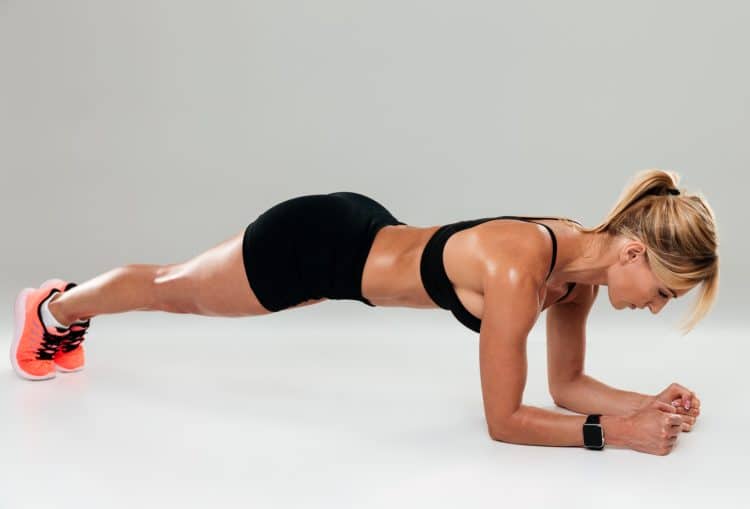Getting ripped abs is a goal for many people looking to get in shape. But what is the best exercise to achieve strong, defined abdominal muscles – crunches or planks? Let’s take a detailed look at the pros and cons of each movement.
What Muscles Do Crunches and Planks Work?

The abdominal area consists of several muscles, including:
- Rectus abdominis – the long vertical muscle that forms the six-pack
- Internal and external obliques – on the sides of the torso
- Transversus abdominis – deepest abdominal muscle, wraps around the torso
Crunches primarily work the rectus abdominis. When doing a crunch, you flex your spine to lift your torso off the ground. This concentrates the movement in the upper abs.
Planks engage all the major core muscles at once. To hold a plank, you maintain a straight, neutral spine. This static contraction recruits the rectus abdominis but also heavily works the deeper transverse abdominis. The obliques are active to prevent lateral swaying.
Crunch Benefits and Drawbacks

Crunches are popular because they directly target the rectus abdominis through its full range of motion. Some benefits include:
- Isolates the rectus abdominis and obliques
- Hits all areas of the rectus when varying hand placement
- Can be done anywhere with no equipment
However, excessive crunching has some risks:
Level Up Your Fitness: Join our 💪 strong community in Fitness Volt Newsletter. Get daily inspiration, expert-backed workouts, nutrition tips, the latest in strength sports, and the support you need to reach your goals. Subscribe for free!
- Puts pressure on the spine in a flexed position
- Limited core activation since other muscles aren’t worked
- Can cause neck strain if improper form
Too many crunches could contribute to low back pain or injuries over time due to repetitively flexing the spine.
Plank Benefits and Drawbacks

Planks offer a safer, more functional training stimulus than crunches. Benefits of planking include:
- Activates entire core musculature
- Teaches body control in a neutral spine position
- Translates well to real-world strength
- Low risk of injury if proper form is maintained
The drawbacks of planking largely relate to difficulty and boredom:
- Isometric holds can be challenging to maintain
- Works the whole body, not just abs
- Not as much rectus abdominis isolation
- Can get monotonous during longer holds
Overall, planks build functional core strength better than crunches – but crunches give more targeted abdominal stimulation.
Which Exercise Is More Effective?
For strengthening the entire core, planks are the clear winner. They force total body tension and true core bracing with little injury risk. Some key advantages of planks:
- Engages transverse abdominis and obliques better than crunches
- Teaches proper spine neutrality during resistance training
- Carries over to deadlifts, squats, presses, and pulls
Crunches do excel at honing the visible six-pack muscles if done properly. To get the benefits of both, the ideal core routine combines planks for overall strength with some crunches for rectus isolation.
Proper Plank Form

To get the most from planking, proper form is critical:
- Keep shoulders over elbows and hips in line with shoulders
- Brace core hard by pulling naval in towards spine
- Maintain neutral spine; don’t sag or pike up hips
- Squeeze glutes and quads to stabilize
- Breathe normally; don’t hold breath
Avoid these mistakes:
- Letting hips sag or rise up
- Caving in or arching lower back
- Letting head/neck hyperextend
- Holding breath; this increases blood pressure
Crunching Safely and Effectively
While planks should form the core of your training, some crunching can enrich abdominal development. Focus on quality reps with good form:
- Keep head/neck in neutral position
- Initiate curl only through upper abs, not hips
- Don’t pull on neck or flare elbows out wide
- Exhale on exertion; don’t hold breath
- Use slowed, controlled tempo; no jerking
- Limit spinal flexion range of motion
Vary crunch hand positions to hit upper/middle/lower abs. Add twists for obliques. Limit total weekly crunches to avoid overuse.
Integrating Planks and Crunches
An effective core routine mixes front, side, and rotational planks with crunches and oblique work. Some guiding principles:
- Do planks 3-4x per week after warm-ups
- Add 2-3 sets of crunches 2x per week after planks
- Include side/rotational planks and oblique crunches
- Use perfect form and focus on muscle control
- Increase plank times and crunch reps gradually
- Allow at least 1 day of rest between core sessions
With smart programming, planks and crunches can team up to build an unbreakable core. Stay safe and be patient for results.
FAQs about Crunches Vs Planks
What’s the primary difference between crunches and planks?
While both exercises target the core, crunches involve repeated flexing of the spine, while planks focus on isometrically holding a rigid body position.
Which exercise is better for beginners?
Planks are generally recommended for beginners as they promote core stability and can help prevent potential back issues associated with poor crunch form.
Do crunches or planks burn more calories?
While the exact calorie burn can vary, planks tend to engage more muscle groups simultaneously and might lead to a slightly higher calorie burn than crunches.
Which exercise is more effective for six-pack abs?
Both exercises can be part of a strategy for defined abs. However, remember that diet and overall body fat percentage play key roles in revealing abdominal muscles.
Are there risks associated with doing too many crunches?
Yes, excessive crunches without proper form can strain the neck and back. Always focus on technique and consider varying your ab exercises.
Can planks help improve my posture?
Absolutely. Planks strengthen the entire core, which includes muscles critical for maintaining proper posture.
How long should I hold a plank for effective results?
Quality over quantity. Start with short durations (20-30 seconds) and focus on maintaining a straight body line. As you improve, aim to hold for longer periods, like 1-2 minutes.
Can I combine both crunches and planks in my workout routine?
Yes, a balanced core workout can include both exercises. This ensures diverse muscle engagement and can prevent workout plateaus.
What are the best crunch variations?
Some top crunch options are:
- Basic crunch – targets upper abs
- Reverse crunch – engages lower abs
- Oblique crunch – hits the side waist muscles
- Bicycle crunch – rotational movement for obliques
- Cross body crunch – hits obliques and upper abs
How long should I plank for?
As a beginner, start with 10-30 second holds and gradually increase your plank times. Intermediate plankers can work up to 60 seconds. Advanced athletes can hold planks for multiple minutes.
Is it better to do a few long planks or more shorter planks?
For strength gains, longer plank holds are ideal. But doing multiple shorter planks accumulates volume. Aim to progress your max plank hold while also doing some shorter sets.
Can planks give me a 6-pack?
Planks strengthen the entire core but don’t isolate the rectus abdominis muscle like crunches. You’ll need a low body fat % for a 6-pack. Planks help build the foundation while crunches polish the finish.
Conclusion
Planks and crunches both have value for building core strength and sculpting six-pack abs. Planks are superior for overall functional fitness – they activate the entire core in a safe, neutral spine position. But isolated crunches help develop the rectus abdominis muscle for an aesthetic finish.
The best approach is to make planks the core exercise in your routine while adding crunches and oblique work a few days per week. Focus on perfect form, gradual progression, and allowing muscle recovery. Be patient and keep your core training consistent.
With smart programming and dedication, planks and crunches can work synergistically to improve posture, support big lifts, and carve that coveted six-pack. A strong yet stable core takes time to develop – but the results are well worth the effort.
Happy Lifting!








